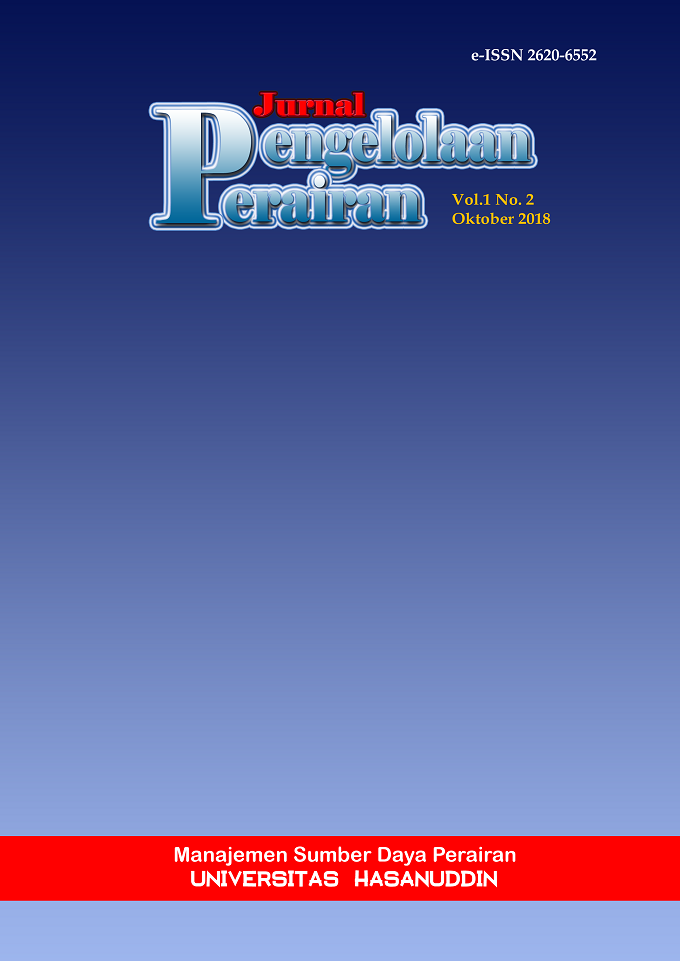Bakteri Konsorsium dari Serasah Mangrove untuk Produksi Kompos (Organic Compost Production from Bacterial Consortium of Mangrove Leaf Litter)
Abstract
Increasing of populations and activities has also increase the town waste, mainly of the organic waste. As nowadays had no comprehensive handled optimally. One option of organic waste processing is by compost production, by means of organic biodegradation. The aim of the research is to find out whether 4 types of bacteria, namely: Psedomonas sp., Flavobacterium sp., Acinetobacter sp., Bacillus subtilis are synergies into consortium bacteria, whether potential consortium bacteria as organic waste decomposing bacteria, how compost from bacteria consortium, , smell, color and temperature. The synergy bacteria test was performed by scraping four types of bacteria on Nutrien Broth medium (NB). Compost processing was done by application of bacterial consortium into the municipal organic waste and incubated for about 8 weeks. The results showed that four types of bacteria, namely: Pseudomonas sp., Flavobacterium sp., Acinetobacter sp., Bacillus subtilis is the synergy and potential as a consortium bacterium. Compost is formed after 4 weeks of incubation with crumbed texture, black color, soil like odor and temperature 28oC.Key words : Bacterial consortium, mangrove leaf litter, organic waste, composting.
References
Deng. Y. dan S.Y. Wang. 2016. Synergistic growth in bacteria depends on substrate complexity. J. Microbiol. (2016) 54 (1): 23-30.
Gaur, A.C. 1982. A Manual of rural composting. In Improving Soil Fertility Through Organic Recycling. Project Field Document No. 15. Food and Agricultural Organization of The United Nation, Tome.
Khiangam. 2014. Screening and identification of cellulose producing bacteria isolated from oil palm meal. Journal of Applied Pharmaceutical Science Vol. 4 (04), pp 090-096, April 2014. Available online at http://www.japsonline.com
Lestari, T. 2015. Kumpulan teori untuk kajian pustaka penelitian kesehatan. Yogyakarta: Nuha medika.
Martinko, J. M.; Madigan, M. T. 2005. Brock biology of microorganisms. ed: Englewood Cliffs, NJ: Prentice Hall.
Nasahi, C. 2010. Peran Mikroba dalam Pertanian Organik. Universitas Padjajaran. Bandung.
Pelczar dan Chan, 2008. Dasar-Dasar mikrobiologi. Jakarta. UI Press
Schlegel, H. G. 1994. Mikrobiologi Umum. Penterjemah Tedjo Baskoro. Edisi keenam. Gajah Mada University Press. Yogyakarta
Todar, K. 2008. Online Textbook of Bacteriology. http://www.text book of bacteriology.net/index.html
Widhitama, S., P. W. Purnomo, A. Suryanto. 2016. Produksi dan Laju Dekompisisi serasah Mangrove Berdasarkan Tingkat Kerapatannya di delta Sungai Wulan, demak, jawa tengah. Diponegoro journal of Maquares. 5(4): 311-319


